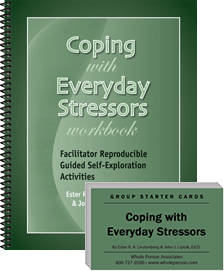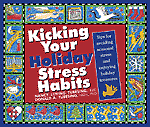Stress – A Problem for All Ages
 Stress Management article and exercises excerpted from Optimal Well-Being for Senior Adults, Vol. 1 by Ester R.A. Leutenberg and Kathy A. Khalsa, CPC, OTR/L and Coping with Everyday Stressors by Ester R.A. Leutenberg and John Liptak, EdD.
Stress Management article and exercises excerpted from Optimal Well-Being for Senior Adults, Vol. 1 by Ester R.A. Leutenberg and Kathy A. Khalsa, CPC, OTR/L and Coping with Everyday Stressors by Ester R.A. Leutenberg and John Liptak, EdD.
We live in a world fraught with stress. Stress has many sources and can bestress generated from within a person through self-imposed thoughts and feelings, while others stressors come from the environment: Stress is completely age tolerant. Our reactions to stress might be different as we get older, but it is out there waiting to pounce.
Stress generated from within a person ‒ Stress can be self-imposed through low self-esteem, anger, feelings of hopelessness, feelings of helplessness, anxiety, perfectionistic tendencies, jealousy and hostility. For example, people who are perfectionistic often bring stress upon themselves by being too careful and worrying about tasks being perfectly accomplished.
Stress generated from the environment – Stress can be felt from the results of environmental catastrophes such as severe storms, earthquakes, tornadoes, hurricanes, floods and acts of war. For example, people who are trying to rebuild their homes and lives after a hurricane find themselves struggling to meet their most basic needs.
Stress generated from conflicts – Stress can be the result of situations in which people are faced with an incompatibility with people, needs, demands, opportunities or goals. For example, a person who does not get along with a co-worker will experience stress on the job.
Stress generated from daily hassles – Stress can be the result of minor irritating annoyances that occur in daily life. Some of these daily hassles may be losing keys, car breaking down, waiting in long lines at a store, waiting for appointments, and getting stuck in traffic. For example, a person having to sit in traffic going to and coming home from work will experience stress.
Stress generated from economic factors – Stress can be the result of economic factors such as losing money in the stock market, not having enough money in retirement, growing inflation, and amassing too much debt. For example, many people have to work later in life because of a lack of enough money to live on in retirement. People may struggle with overcrowded housing, inadequate heating or air-conditioning, dangerous neighborhoods, etc.
Stress generated from changes in families – Stress can be the results of changes in the family such as parents’ separation, divorce, blended families, loss of loved ones, change in residence, birth of a child, adoption, changes in health of family members, and caring for aging parents. For example, people who are forced to care for aging parents often feel guilt, and are stressed because it takes time away from work and other family obligations.
Stress generated from changes at work – Stress can be the result of changes on a job, loss of work, changes in a role played at work, uncomfortable physical demands in the workplace, a lack of safety, interpersonal demands such as an abrasive supervisor or co-worker, and having too much work to complete. For example, a person who must work with an abrasive supervisor will feel uncomfortable most of the work day. In order to successfully deal with all of the various types of stress, people must find creative ways of coping. The exercises that follow will help you manage your stress and move forward to lead a happy, healthy life.
The stress experienced by seniors is greatly impacted by past lifestyle choices and the tools we have learned to cope with our stress. Stress Management – Past and Present will help clarify those skills that work well and those that do not.
Stress Management – Past and Present
The lessons we learned in our past inform us on how we manage stress now. Answer the following questions in your journal or discuss them with a friend. If you wish, click here to access a printable version of the worksheets.
In your past:
- Think back to your childhood. How did the adults in your life manage their stress?
- As a child or teenager, how did you manage your stress?
- What is a memory from your childhood or teen years when you managed stress in an unhealthy way?
- What is a memory from your childhood or teen years when you managed stress in a healthy way?
In the present:
- What was one way in the last month that you managed stress?
- When you are at home, what is one stress management activity that is immediately accessible?
- Who is one person in your life, who can support you in managing stress well?
- What is one goal or boundary that you can set to assist you in stress management?
How did the lessons you learned in your past inform how you manage stress now?
Physical Distress Symptoms
How you move and hold your body tells a great deal about your level of stress and physical wellness. Look at the list of stress symptoms below. Which of these do you exhibit and when do you find yourself experiencing them? In your journal list the symptoms and write about when and with whom you experience them. Write about how you might overcome this. If you wish, click here to access a printable version of the worksheets.
Foot tapping (impatience)
Tight, hunched shoulders (anxiety or frustration)
Tightly folded arms (anger or disappointment)
Sagging shoulders (fatigue)
Biting nails (anxiety or worry)
Frowning forehead (worry or fatigue)
Clenched teeth (stressed)
Biting or Licking Lips (nervousness)
Downturned corners of mouth (disapproval)
What other physical distress symptoms do you exhibit? Write about those as well.
Stress Relief A to Z
Good coping skills are a must to handle the stress we all experience. On the left you will find a list of skills. In your journal write what you would do, following the A to Z pattern. If you wish, click here to access a printable version of the worksheets.
| Stress Relief A to Z
Examples |
Your Own Stress Relief A to Z Suggestions
|
| Avoid negative people. | A |
| Be yourself. | B |
| Change your thought. | C |
| Don’t think you know all the answers. | D |
| Exercise often. | E |
| Feed the birds. | F |
| Give someone a hug. | G |
| Hum a joyful song. | H |
| Invite a friend to dinner. | I |
| Join others when invited. | J |
| Keep a journal. | K |
| Look up at the stars. | L |
| Make duplicate car or house keys. | M |
| NO! Just say it with no excuses. | N |
| Open a door for someone. | O |
| Pet a friendly dog or cat. | P |
| Quit trying to fix other people. | Q |
| Repair things that don’t work properly. | R |
| Stand up and stretch. | S |
| Take a shower. | T |
| Use time wisely. | U |
| Visualize yourself relaxing. | V |
| Walk in the rain. | W |
| X–plore a new idea. | X |
| Yak with a friend. | Y |
| Zoom into a healthy restaurant. | Z |
To download a digital copy of these stress management worksheets, click here.


 Reaching adulthood does require a degree of buckling down and getting serious. Let’s face it – there are things we have to do whether we want to or not. But so many of us have lost the sheer capacity for fun, joy, and laughter that even when we have the opportunity, we miss it.
Reaching adulthood does require a degree of buckling down and getting serious. Let’s face it – there are things we have to do whether we want to or not. But so many of us have lost the sheer capacity for fun, joy, and laughter that even when we have the opportunity, we miss it.
